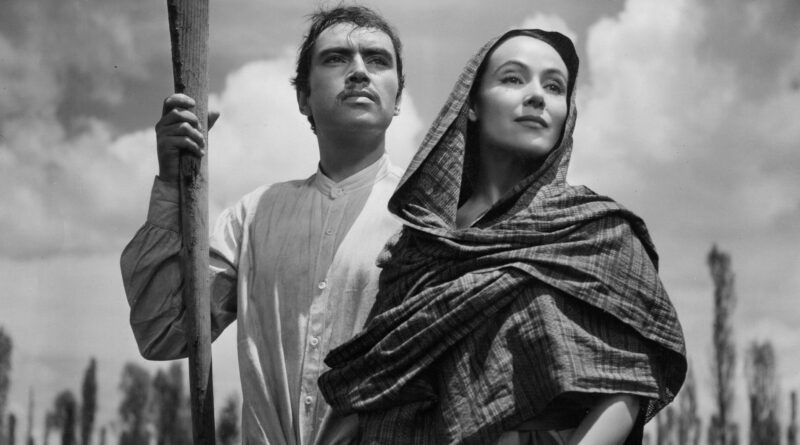Restored Treasures from Latin America at MoMA’s To Save and Project Festival
The Museum of Modern Art has announced the lineup for the 21st edition of its annual To Save and Project Festival of Film Preservation, taking place January 9–30, 2025, in New York City. Spanning nearly a century of cinema, the program includes six films by Latin American and U.S. Latinx directors: Rosaura at 10 O’Clock / Rosaura a las 10 by Mario Soffici from Argentina; María Candelaria by Emilio Fernández and Roberto Gavaldón’s Adventures of Casanova / Casanova aventurero, both from Mexico; A Real Woman / Mulher de Verdade by Alberto Cavalcanti from Brazil; After the Earthquake / Después del terremoto by Latina directros Lourdes Portillo and Nina Serrano; and A Circle in the Fire by Peruvian-American director Víctor Núñez.
Rosaura at 10 O’Clock, Mario Soffici’s adaptation of Marco Denevi’s celebrated first novel, emerged during a watershed moment in Argentine cultural history, as the nation’s artists and intellectuals sought to redefine national identity in the wake of Peronism. Soffici, who had helped establish Argentina’s studio system in the 1930s, brings his classical visual precision to bear on Denevi’s postmodern narrative games, creating a work that simultaneously honors and transcends its popular genre origins.
Set within the hothouse atmosphere of a Buenos Aires boarding house, the film follows the timid painter Camilo Canegato (Juan Verdaguer), whose carefully maintained solitude is disrupted by the arrival of perfumed letters from a mysterious admirer called only “Rosaura.” As the other residents become increasingly invested in this unlikely epistolary romance, Soffici orchestrates a delicate dance between reality and desire, culminating in the physical manifestation of the enigmatic Rosaura herself.
Winning both the Palme d’Or and Best Cinematography awards at the 1946 Cannes Film Festival, María Calendaria marked Mexico’s entry into the highest ranks of world cinema. The floating gardens of Xochimilco provide a lyrical background to a self-consciously mythological tale of a pair of lovers (Dolores del Río and Pedro Armendáriz) menaced by a covetous shopkeeper (Miguel Inclán, Mexican cinema’s Man You Love to Hate). Cameraman Gabriel Figueroa brilliantly finesses that most difficult of lighting situations: nighttime on water. Director Emilio Fernandez captures the spirit of Mexico’s great muralists with his epic vision of a noble peasantry exploited by the petty bourgeoisie.
Shot at Mexico’s newly established Estudios Churubusco, Adventures of Casanova demonstrates Mexican cinema’s ability to match Hollywood production values at their height. The film reimagines Casanova as a Sicilian freedom fighter, with the colonial-era Mediterranean setting allowing the studio to repurpose the extensive period architecture and costumes it typically used for Spanish colonial dramas.
Eagle-Lion Films’ choice to produce at Churubusco, then emerging as Mexico’s premier facility through its partnership with RKO, paired Mexican superstar Arturo de Córdova with Hollywood talent Lucille Bremer and Turhan Bey. Under the assured direction of Roberto Gavaldón, fresh from his masterwork La Otra, and with superb cinematography credited to Poverty Row veteran Jack Greenhalgh, the film exemplifies the technical sophistication of Mexico’s Golden Age cinema while offering a unique hybrid of Hollywood adventure and Mexican production craft.
After decades of celebrated work in Europe, Alberto Cavalcanti returned to his native Brazil to make this sophisticated satire of class and gender relations. What begins as a seemingly light comedy about a woman caught between two marriages—one to a reformed petty criminal, another to a wealthy playboy—develops into a pointed critique of Brazilian society. Popular singer Inezita Barroso, in an early film role, brings remarkable complexity to Amelia, a character who becomes a reluctant bigamist simply because society never allows her to say no. Cavalcanti’s refined visual style, developed through his work with the French avant-garde and Britain’s Ealing Studios, creates telling contrasts between Amelia’s humble domestic life and the artificial world of São Paulo’s elite. This restoration rescues a key work—long overlooked in discussions of Brazilian cinema—from one of world cinema’s most cosmopolitan directors.
A groundbreaking early work from acclaimed Chicana filmmaker Lourdes Portillo, After the Earthquake emerged during the 1970 renaissance of political cinema, and represents a significant intersection of feminist filmmaking and Latin American diasporic narratives. Shot in grainy black and white, this dramatic short follows a young Nicaraguan woman who has immigrated to San Francisco in the wake of the 1972 Managua earthquake, enduring both personal and political aftershocks as she navigates her new reality.
Victor Nuñez’ 50-minute adaptation of Flannery O’Connor’s haunting short story, A Circle in the Fire, marks the transition between his UCLA student shorts and his studio films. The story follows Mrs. Cope (Betty Miller), a proud farm owner whose carefully ordered world is disrupted by three teenage boys, led by the son of a former worker. Their unwanted presence escalates from nuisance to threat, culminating in an act of biblical proportions.
*Fuente: Cinema Tropical

